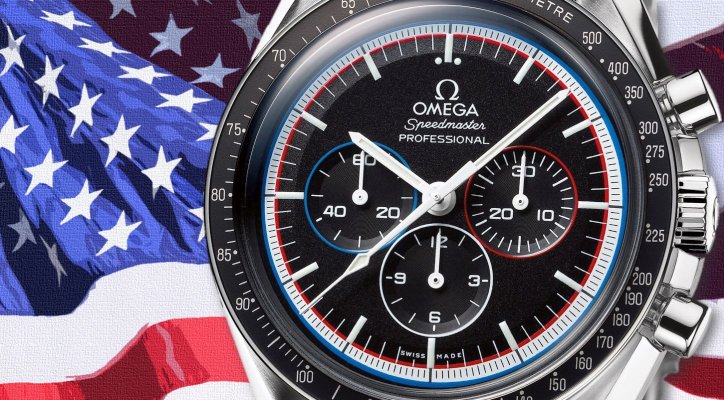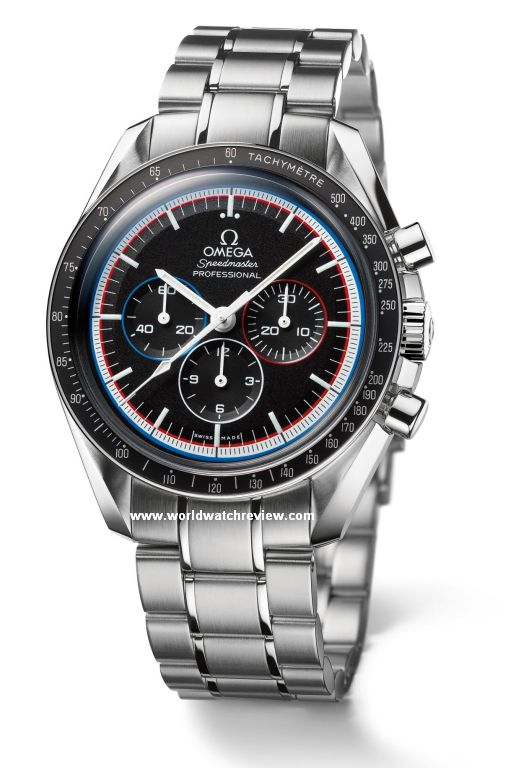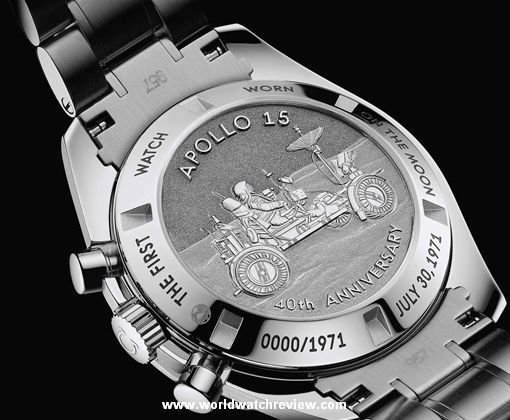
Celebrating the upcoming anniversary of the Apollo 15 mission (it happened on the 26th of July, 1971,) the Swiss brand has prepared a new Omega Speedmaster Moonwatch “Apollo 15” 40th Anniversary Edition (ref. 311.30.42.30.01.003) chronograph.
Like the rest of the series, the “Apollo 15” comes in a 42 mm stainless steel case.
Equipped with a fixed bezel with an inevitable tachymeter scale, the “Apollo 15” can be considered medium-sized by today’s standards.
However, thanks to fairly long (but beautifully shaped) horns, on some wrists this one may look like a 50 mm diver, so don’t forget to pay a visit to your local authorized dealer and try this one on first.

Thanks to the modest size of the case and the lack of date aperture, the dial looks extremely well-balanced.
If you take a moment to regard this beautifully executed job, you will notice that every single detail of the dial is designed in such a way as to complement one another.
Even the iconic triangle that consists of the famous Ω symbol and the “OMEGA,” “Speedmaster” and “PROFESSIONAL” letterings is in its rightful place here counterweighting with ease the three sub-dials.
Visually, this iteration differs from other “Moonwatches” only with the chosen color scheme.
Besides the usual black and white, there are also blue and red: the official colors of the Apollo program.
The minute track features the whole blue, white and red stripe, while the recessed sub-dials feature their own colors.
The small seconds sub-dial at 9 o’clock features a blue rim, while the 30-minute and 12-hour chronograph counters sport red and white-colored rims respectively.
The new timekeeper comes equipped with the Caliber 1861 hand-wound movement, which is based on a Lemania 1873 design.
The movement comes in two different finishes depending on the model.
If the watch in question is equipped with a display back, the Caliber 1861 is delivered with its chronograph bridge and other parts featuring a flawlessly executed Geneva stripes pattern.
If like in this particular case, the watch sports a solid case back, it is equipped with a simpler version, which is only rhodium-plated and even has one plastic part.

Nevertheless, the movement is good and reliable, which is proved many times both by official NASA tests as well as numerous space missions performed by American astronauts and Soviet cosmonauts (the Russians are now supplied by mechanical timekeepers made by another Swiss watchmaker: Fortis.)
It must be noted, however, that the 40th Anniversary model is not mechanically identical to the original “Moon Watch” that was used by American astronauts on the first Apollo missions.
The original 1965 model sported Cal. 321 movement that was also manually wound but featured a more accurate column-wheel chronograph subsystem. The chronograph mechanism of the Cal. 1861 features a simplified Shuttle/Cam system.
The newer movement also works at a higher frequency of 21,600 vph and utilizes a flat Nivarox balance spring instead of the Breguet overcoil design in the Cal. 321.
There is still no information regarding the model’s price, but, like other numerous “limited editions” in the Speedmaster Professional series, it will possibly retail at around $6000.
The manufacturer plans to limit the model’s production to 1971 pieces. Very symbolic, that, although I somehow doubt that the watch will become a rarity in any foreseeable future: there are just so many of them.
See also: Breitling Transocean Chronograph 01 Limited Edition
Photos: Omega
Omega Speedmaster Moonwatch “Apollo 15” 40th Anniversary Edition (ref. 311.30.42.30.01.003) specification
Price: $6800 (MSRP)
Movement: Hand-wound, Caliber 1861 (base Lemania 1873,) 18 jewels, 21,600 vph, Swiss Made
Movement decoration: Rhodium-plated
Functions: Hours, minutes, small seconds, chronograph
Power reserve: 48 hours
Case: Stainless steel
Shape: Round
Size: 42.00 mm
Dial: Matte black
Hour markers: Luminous
Hands: Luminous
Water resistance: 50 meters
Strap: Stainless steel bracelet
Crystal: Hesalite acrylic crystal
Back: Solid, embossed with an image of the Lunar Rover and the words “Apollo 15” and “40th Anniversary”
